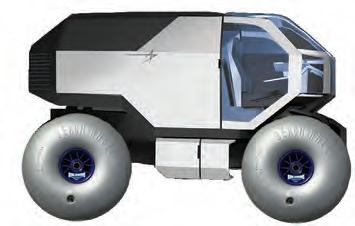





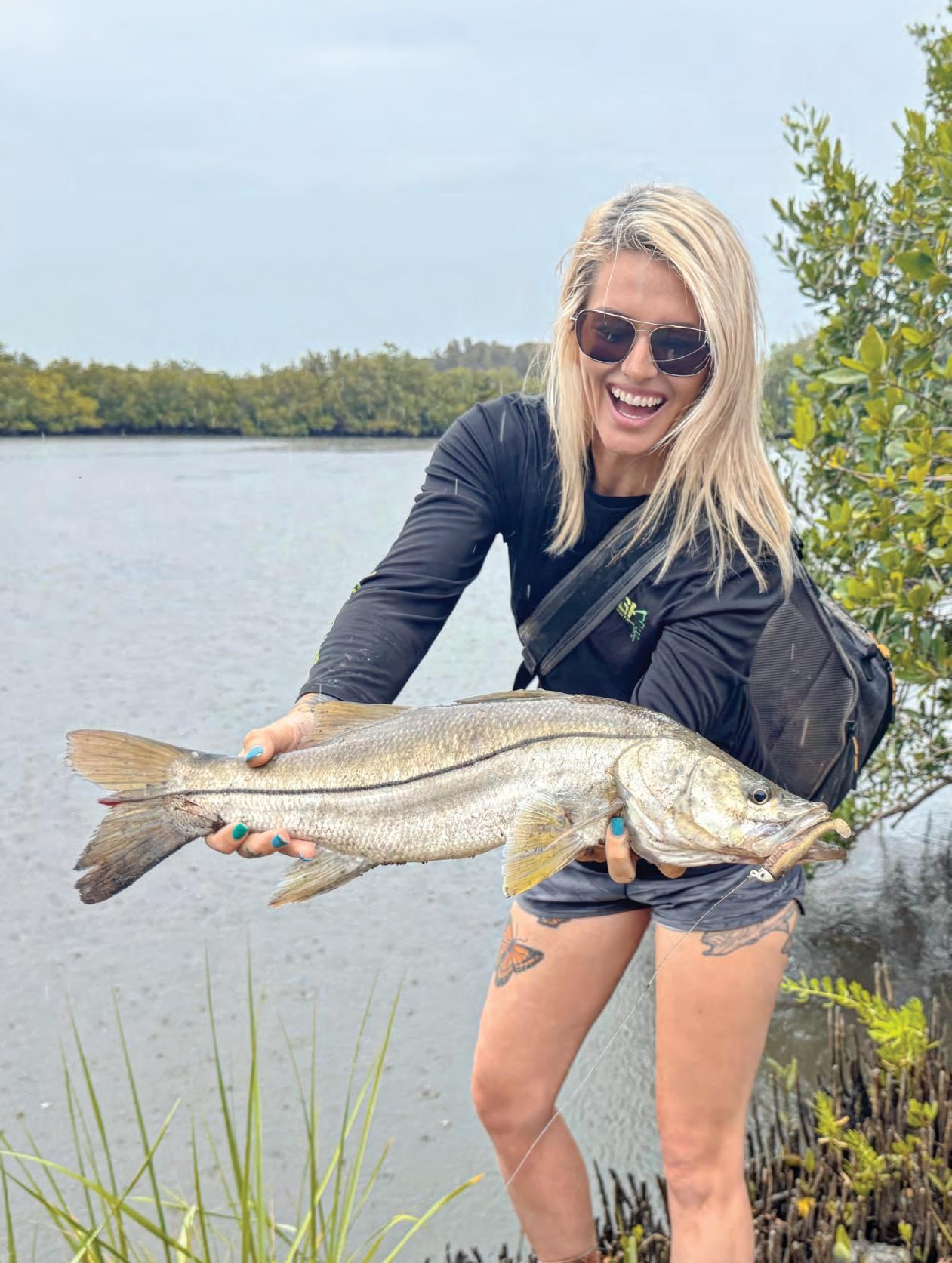



You want new charts?
You got new charts! Explore the ocean with vibrant terrain & depth shading, using all-new TZ MAPS. Don’t just take our word for it. See for yourself. Scan here, and we’ll show you!
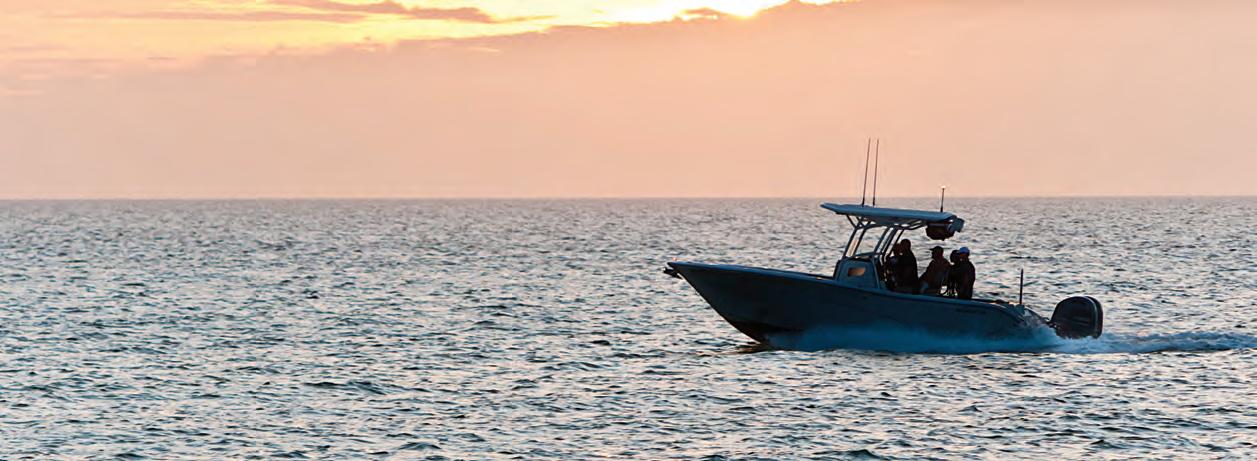
Are you ready to embark on your next on-water adventure? Before you set sail, here are fve things to know about boat insurance.
1. Boat insurance isn’t just for accidents
With comprehensive coverage, you’ll also be protected fnancially for theft, vandalism, and unexpected events like storms if you need repairs or replacements due to damage.
2. Accidents can happen to anyone
When accidents happen, boat insurance offers liability coverage for damages or injuries you cause while boating, up to specifed limits. It can also cover lawsuit costs if you’re sued.
3. Boat insurance can cover medical payments
Boat insurance offers a range of optional medical payments coverage limits, helping to cover medical expenses if you’re in an accident or someone is hurt on your boat, regardless of fault.
4. Most lenders require boat insurance
If you fnanced your boat, you’ll likely need boat insurance since most lenders require boat insurance to protect their investment. Additionally, some marinas or municipalities require proof of insurance for docking.
5. Progressive offers specialized boat coverages
Ever worry about getting stuck on the water?
Progressive’s Sign & Glide® On-Water Towing coverage** can help. It’s an additional coverage that steps in if your boat is disabled or breaks down on the water, paying for on-water towing, jump starts, soft ungroundings, and fuel delivery. Fuel cost isn’t included.
Don’t let unforeseen circumstances disrupt your voyage. Cruise with confdence thanks to Progressive Boat insurance. Because when it comes to your boat, peace of mind is the ultimate luxury.
Scan to get a quote in as little as 4 minutes.
to learn more.




















By Skye Burkhardt

In recent years, paddleboard !shing has quietly emerged as one of the most immersive and rewarding ways to !sh, particularly in the backwaters where nature whispers and big !sh lurk in shallow, untouched waters. Combining the stealth of a kayak with the freedom and perspective of stand-up paddling, paddleboard !shing o ers a unique experience that connects anglers to their environment in a deeply personal way. You become part of the environment—just another element in a quiet, dynamic system. Every ripple matters, every shadow could be a !sh. It’s !shing stripped to its essentials: a board, a rod, and your wits.
Backwaters—those slow-moving or stagnant tributaries and tidal creeks separated from larger bodies of water—are havens for !sh and wildlife. ey’re o en shallow, weedy, and di cult to access with motorboats, making them ideal for paddleboards. ese secluded waterways harbor species like red!sh, snook, bass, tarpon, and trout, depending on your region. e calm water allows for sight !shing and careful stalking, while the surrounding vegetation provides natural structure and cover for !sh. For anglers seeking peace, solitude, and the thrill of spotting and targeting !sh in crystal-clear shallows, backwaters are unmatched.
Paddleboards o er several distinct advantages in the backwaters:
• Maneuverability: ey can access shallow and narrow areas where boats can’t go.
• Stealth: Paddleboards glide silently, allowing
you to approach !sh without disturbing them.
• Sight Fishing: Standing gives anglers a better vantage point to see !sh and structure below the surface.
• Portability: Easy to transport and launch, paddleboards can be carried to remote areas with little e ort.
• Minimal Impact: Paddleboards have a low environmental footprint, making them a great choice for conservation-minded anglers.
Fishing from a paddleboard requires packing smart. Space is limited, so prioritize:
• Rod and Reel: A medium-action spinning setup is versatile for most species.
• Tackle Box: A compact, waterproof tackle box with your go-to lures, so plastics, hooks and leaders.
• Anchor or Stakeout Pole: To hold position in wind or current.
• Cooler: Dual-purpose for storage and seating.
• PFD (Personal Flotation Device): Required by law and essential for safety.
• Dry Bag: Keep your phone, wallet, and other valuables safe.
• Sun Protection: Hat, polarized sunglasses, and sunscreen are must-haves.
1. Practice Paddle Control: Master basic paddling and balance techniques before trying to !sh while standing.
2. Stay Organized: Use carabiners and bungee cords to keep gear secure and accessible.
3. Scout the Water: Stand and scan for tailing
!sh, bait activity, or subtle ripples.
4. Be Patient: Quietly dri or pole through likely spots, and avoid sudden movements.
5. Time Your Trip: Early morning and late evening o er cooler temps, calmer water, and more active !sh.
Paddleboard !shing in the backwaters is more than a hobby—it’s a return to simplicity and intimacy with nature. It’s a growing movement that emphasizes low-impact adventure, selfreliance, and a deep appreciation for wild, o en overlooked places. Whether you’re targeting snook in a mangrove tunnel, bass in a hidden freshwater creek, or red!sh on a mud at, the experience of !shing from a paddleboard is less about the catch and more about the connection— to the water, the !sh, and yourself. For anglers ready to trade noise and crowds for silence and solitude, the backwaters await.
If you’re interested in paddleboard !shing, but don’t have the equipment or gear, be sure to enter my “Ultimate Halloween Paddleboard Fishing Package” giveaway presented by Coastal Angler Magazine, where you could score a “Tricked Out” Live Watersports paddleboard equipped with an ePropulsion eLite electric motor, paddleboard !shing gear and accessories, apparel and more! Scan the code in the ad on the next page or visit coastalanglermag.com/CAM-giveaway for more details and to enter.
Find Skye Burkhardt on Facebook at “Inshore Adventures With Skye,” and on Instagram: @brassyangler87.



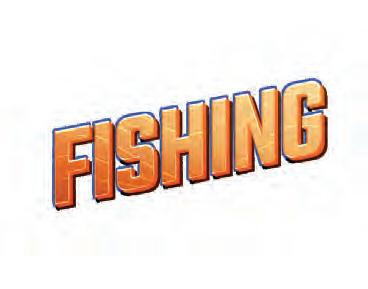




















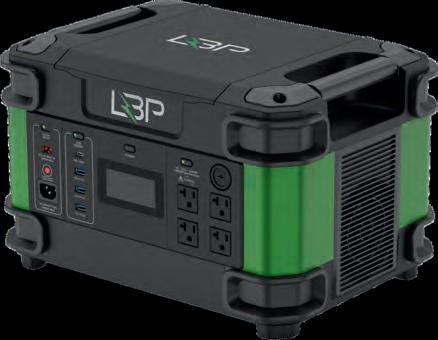




Lithium Battery Power (LBP), a leading innovator in advanced battery solutions, has taken top honors in the Energy category at the 2025 International Convention of Allied Sport!shing Trades (ICAST). e company’s groundbreaking Powerbox 2.5 kW / Solar Panel Lithium Battery Charging System was awarded the Best of Category: Energy, signaling a major leap forward in sustainable, high-performance energy technology for anglers and outdoor enthusiasts.
Held annually in Orlando, ICAST is recognized as the world’s largest sport!shing trade show and a hub for innovation within the industry. Each year, hundreds of new products are submitted for consideration across multiple categories, but only the most impressive make it to the winner’s circle. LBP’s Powerbox system stood out for its combination of portability, power, and green energy integration. e award-winning Powerbox 2.5 kW system delivers robust, reliable energy storage and output
in a compact, rugged form factor. It’s designed to meet the demanding needs of outdoor enthusiasts who rely on consistent power in o -grid environments. Integrated with a high-e ciency solar charging panel, the system ensures power sustainability even during extended trips, reducing the need for fuel-powered generators or frequent dock visits.


outages, hurricanes and critical jobsite power along with the heavy 12 volt demands in marine environments got their attention over all others in the Energy category.
“We are honored to receive this recognition at ICAST,” said Don Mitchell, Sales Director for Lithium Battery Power. “Our goal has always been to push the boundaries of battery technology while supporting eco-conscious outdoor recreation. e Powerbox system is a direct response to what today’s anglers need— power that lasts, in a package that’s smart, clean, and easy to use.”
e judges at ICAST praised the Powerbox for its innovative design, versatility, and emphasis on clean energy. Weekend power
is win marks a signi!cant milestone for Lithium Battery Power, reinforcing its position as a leader in the renewable energy sector within recreational vehicle and marine markets.
As the industry shi s toward more sustainable and e cient energy solutions, Lithium Battery Power’s win at ICAST 2025 signals that the future of on-the-water power is not just electric - it’s solar, smart, and built for adventure.

By Will Schmidt
If you have spent any time bottom !shing you know that occasionally on the heaviest of tackle you can outsmart a big snapper and end up with a solid !sh. Other days you can struggle to get even shorts. If you really want to up your game, it is time to lighten up.
When I say light, I mean straight 20 or 30lb mono and light wire 3/0 hooks. You may get broken o at times, but it is worth it for a box full of stud mangos and ARS. My go to big snapper setups is G Loomis IMX Pro Blues 843 casting rod with Shimano Trinadad TN20. is out!t is light, sensitive, and deadly on snapper. Some might like a bit lighter action rod but I have found that even with straight 20lb test you can really put a lot of pressure on these !sh and the backbone is nice to get them o the bottom as quickly as you can. A bit heaver is also nice when that grouper inevitably grabs the bait.
Here is a pro tip. One of the key elements for success to get big snapper, especially mangos, is the ability to react fast. Snapper get their name because they will o en quickly snap at a bait and then release it. With these sensitive rods and a gear ration of 6.2 to 1 you can pick up 46 inches of line in a single turn. A sensitive rod and a fast
reel means when you feel that tap, you can come tight instantly even in deep water. Remember you must use circle hooks so reeling vs setting the hook is the way to connect to these A fast reel might be the most important tool when snapper !shing.
My go to bait is a live pin!sh because, everything eats a pin!sh. I like having a livewell full of nice hand size pins. I do also use thread!ns both live and dead. read are great baits, but a good stout live 7 inch thread is remarkably strong and can be tough to get to the bottom as they swim o with your lead. at means dead threads can be easier to get to the strike zone. Cut the heads and tails o and make a thread “plug.” read “plugs” are awesome for snapper bait especially when live bait is not available. If hook ups are tough, I will double up my hooks, snelling 2 circle hooks close together and getting both hidden inside the plug to increase my hookup ratio. Regardless, I use 3 to 4 feet of mono leader then a swivel and a 3 ounce lead to hold the rig right on the bottom.

light and you will likely !nd the results are worth it.

Whether you really want to target big snapper or the bite is just really tough, try going
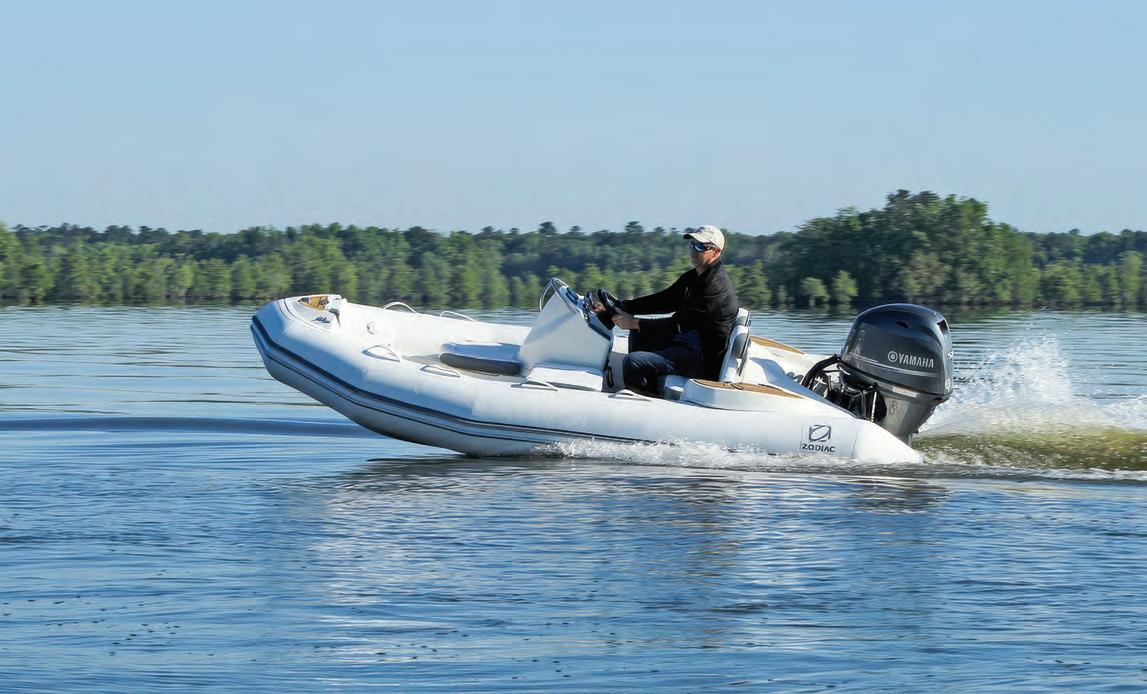














































































It’s no secret that fall and winter are my favorite times to fish in Coastal North Carolina. September is the beginning of what I live for. We will start to see our first north east wind, big high pressure and cold fronts coming through at the end of the month with the giant schools of mullets and menhaden coming down the beach in the beginning of the month. Along with these schools of mullets and menhaden will be Tarpon, Spinner sharks, old drum and Cobia.
Of course, I like to Grouper fish, and I spoke about that in the national section of the magazine but now is when we need to focus on the inshore fishing as well.
Yes, August was hot but don’t ever count out the first couple or three weeks of September as being the hottest time of the year. This is just one good reason to be nocturnal. I sell Boat lifts for a living so of course I like to fish around (Boat Lift Us) lifts that are equipped with the correct lighting systems to become nighttime entertainment centers. When you have the correct lighting, you attract all the shrimp, glass minnows, mullets, etc. and therefore you attract all the Trout, drum and Flounder. See the attached link to the video on my YouTube channel. This is literally like shooting them in a bucket. I will caution you to be quiet when fishing on the dock at night because you are directly over their heads. If you make a lot of noise, be it loud music, stomping your feet, slamming coolers, etc., etc., you will turn the fish off and give them lockjaw. If you are quiet and keep catching them without making a tremendous amount of noise they will continue to bite. Of course, I like a shrimp lure and nothing fishes a 3 inch DOA shrimp body like the Barefoot Jig … As seen in the video.
Yes, I like to fish a double tackle at night as well. Some nights they like the jig, and some nights they like the trailer shrimp with


no weight. Depending on the water depth you have around your dock/boat lift, you may want to fish underneath a cork at night. This will keep the jig and the trailer shrimp swimming at the correct depth properly. Sometimes the larger fish are outside of the lights in the dark water. This is when the cork can be especially effective. You don’t need to “pop” the cork a lot… just barely keep it moving. You don’t have to worry about using glow-in-the-dark colors or real bright colors at night, as they see the (live) shrimp that are almost invisible anyway perfectly at night. As a matter of fact, one of the most effective colors at night is dark brown or black. During the colder months of the year, when there is very little algae in the water and the water is very clear, a dark color shrimp is often more effective. It’s not only Speckled Trout under the lights, but the drum and Flounder are drawn to the light as well. Watch the video and draw your own conclusions.
This is a great place to entertain your children and grandchildren at night around the dock without even having to get in the boat, which can be very intimidating to youngsters. It gets dark early, so flick the lights on and take your kids outside. Get them away from the television, tablets and phones and do what dads and grandpas do best … go catch some fish, live in the moment and be very thankful for all we have.



























































































TThe good ‘ol NCDMF has decided to give recreational anglers in NC a 2 week flounder season this year. How generous. The season will run from Sept 1-14 and the limit will be 1 per person at 15”. The man with a fishing hook and a pointed stick is not the problem with this fishery but that’s a conversation for another day. Let’s discuss a few of my favorite flounder tactics.
he good ‘ol NCDMF has decided to give recreational anglers in NC a 2 week flounder season this year. How generous. The season will run from Sept 1-14 and the limit will be 1 per person at 15”. The man with a fishing hook and a pointed stick is not the problem with this fishery but that’s a conversation for another day. Let’s discuss a few of my favorite flounder tactics.
Most people don’t have the best understanding of flounder or their movements, let’s discuss that a little. Flounder are just like a lot of other fish, they move around in groups and schools. Remember that day you caught 65 flounder and 25 of them were really nice? That is why. You were in a group of fish and they were on the feed. Flounder are also creatures of habit. That same pilon or log will hold an 8 pound flounder again and again year after year. If it was productive once, it will be again.
Most people don’t have the best understanding of flounder or their movements, let’s discuss that a little. Flounder are just like a lot of other fish, they move around in groups and schools. Remember that day you caught 65 flounder and 25 of them were really nice? That is why. You were in a group of fish and they were on the feed. Flounder are also creatures of habit. That same pilon or log will hold an 8 pound flounder again and again year after year. If it was productive once, it will be again.
If I am targeting flounder with live bait, I usually use a Carolina rig with as light of a weight that I can get away with. I use 18-24” of Fluorocarbon leader and I base the strength on the structure I am in, if any. Usually 25# leader. I use a kahle hook based on the bait size. The larger the bait the larger the hook. For bait I like spots, killi, finger mullet and menhaden. Live shrimp will get the job done as well. Deepwater structure like bridges, rock piles and docks are almost sure to produce. I personally like to fish ledges inshore and hard bottom in 12-15’ with live bait. If you’re fishing these types of areas and are not hooked up pretty quick, the flounder are not there or they are not feeding.





If I am targeting flounder with live bait, I usually use a Carolina rig with as light of a weight that I can get away with. I use 18-24” of Fluorocarbon leader and I base the strength on the structure I am in, if any. Usually 25# leader. I use a kahle hook based on the bait size. The larger the bait the larger the hook. For bait I like spots, killi, finger mullet and menhaden. Live shrimp will get the job done as well. Deepwater structure like bridges, rock piles and docks are almost sure to produce. I personally like to fish ledges inshore and hard bottom in 12-15’ with live bait. If you’re fishing these types of areas and are not hooked up pretty quick, the flounder are not there or they are not feeding.
Soft plastics are my favorite way to fish for flounder. I use the lightest jig head I can get away with and I like some current or a moving tide. Usually ¼ ounce or up to 3/8 if it is really bad. For colors I like red, black, purple, white and pink. Colors like opening night and magic grass. I’ve caught them on literally every color under the rainbow. It’s more about finding an area holding fish, and if they are feeding than anything else. I like Saltwater Assassin plastics and will use 5” shad, 6” sea shad and 4” shrimp cocktail. I pair the Saltwater Assassin baits with a generous amount of Pro-Cure Super Gel. Berkely Gulp! holds its own when it comes to flounder, that’s no secret. Something about a Gulp flounder just love. 5” Swimming mullet and 4” Shrimp are my favorites for Gulp. White, new penny and chartreuse are the colors. If you’re missing fish, let them have it a few seconds before setting the hook hard. Most of the time the soft plastic bite is aggressive but not always.
I like to target points, shallow shelfs close to deepwater, cuts in the shoals, and structure like stump beds. You don’t want a plastic dragging the bottom, you want to sweep the area if in current. Hop the bait across the bottom, don’t drag it. Fan cast an entire area and move on if no strikes. Keep on moving and you will find them!
Soft plastics are my favorite way to fish for flounder. I use the lightest jig head I can get away with and I like some current or a moving tide. Usually ¼ ounce or up to 3/8 if it is really bad. For colors I like red, black, purple, white and pink. Colors like opening night and magic grass. I’ve caught them on literally every color under the rainbow. It’s more about finding an area holding fish, and if they are feeding than anything else. I like Saltwater Assassin plastics and will use 5” shad, 6” sea shad and 4” shrimp cocktail. I pair the Saltwater Assassin baits with a generous amount of Pro-Cure Super Gel. Berkely Gulp! holds its own when it comes to flounder, that’s no secret. Something about a Gulp flounder just love. 5” Swimming mullet and 4” Shrimp are my favorites for Gulp. White, new penny and chartreuse are the colors. If you’re missing fish, let them have it a few seconds before setting the hook hard. Most of the time the soft plastic bite is aggressive but not always. I like to target points, shallow shelfs close to deepwater, cuts in the shoals, and structure like stump beds. You don’t want a plastic dragging the bottom, you want to sweep the area if in current. Hop the bait across the bottom, don’t drag it. Fan cast an entire area and move on if no strikes. Keep on moving and you will find them!
CAPTAIN ALLEN JERNIGAN Breadman Ventures Guide Service 910-467-1482




































































The 34th Annual Rotary Club of Sneads Ferry King Mackerel Tournament is in the books and was another great success. Most noteworthy this year was a change in venue from the New River Marina on the ICW to the Sneads Ferry Marina right on the New River. Hosts/Owners Tim Lanier and Jimmy Everett went above and beyond to prepare the site on relatively short notice, and all anglers and patrons were well-impressed with the venue, which will only improve in the years to come.
Now to the fishing: 111 boats registered, with 89 boats electing to fish Saturday, and 22 on Sunday. Saturday weather was a little more sporting, with scattered showers and thunderstorms in the area all afternoon. Sunday featured clear skies and light winds for the entire day. Low to moderate seas made for comfortable conditions both days.
When the results were all in, L.H. Turner’s Motley Crew brought in the big King at 42.96 pounds. The Crew brought this fish in on Saturday afternoon and had a tense Sunday awaiting the outcome, especially when
the second-place boat, Surf N Turf, brought in a 41.7 pounder at 4 PM Sunday. Mas Agua, skippered by venue host Jimmy Everett, took third place with a 40.98 pound King, so less than two pounds separated the top three places! See complete results on the Rotary Club of Sneads Ferry KMT Facebook page.
Also of interest was the Dolphin TWT. In the past few years, the tournament had seen nothing larger than about an 8 lb mahi, but this year, the winners aboard Traveler brought in a 27.3 pound whopper!
All in all, it was a great weekend for the anglers, patrons, and especially the beneficiaries of this tournament: the local community. All proceeds go back into the community for things like scholarships, support of food banks and homeless womens’ shelters, local school athletic programs, and so much more. Many thanks to all sponsors, ad buyers, and patrons for your tremendous and continuing support of this tournament.
See you in 2026!

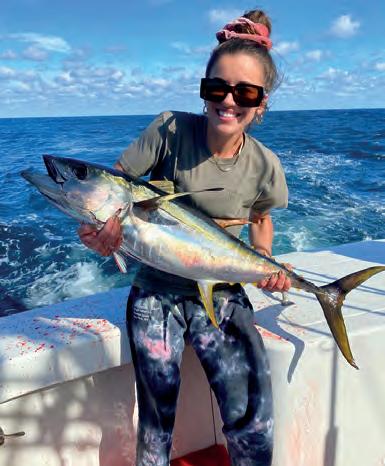



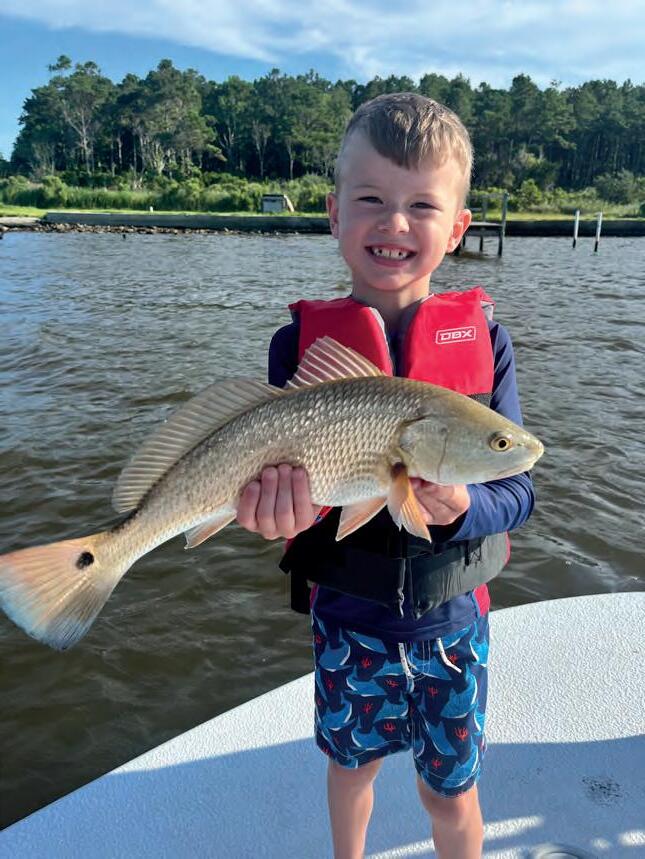
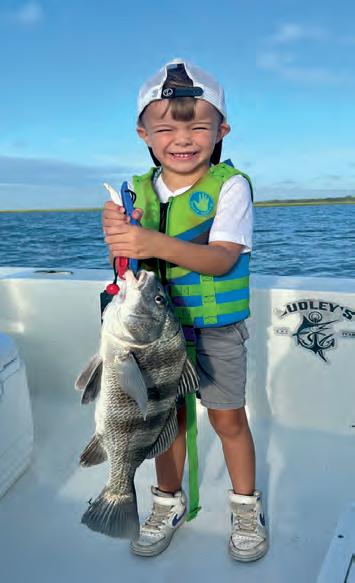



Sight casting at 1st light. Huge schools of 4lb+ Spanish were cutting on bait. Used my trout rod set up and had an epic 30 mins.
School may be back in session and summer vacations wind down, but that doesn’t mean it’s time to hang up your fishing gear. September is one of the best-kept secrets for anglers along the North Carolina coast. The weather is still warm, the water’s inviting, and the summer crowds have thinned out—leaving you more room to cast and relax.
Offshore, things are still hopping. Calm seas make it easy to head
Species Sep Oct
Amberjack Good Good
Black Drum Great Great
Bluefish Great Great
Cobia Good Fair
Flounder Great Great
Kingfish Good Fair
Mahi Mahi Great Good
Marlin Great Good
Redfish Great Great
Sailfish Great Good
Speckled Trout Great Great
Tarpon Great Great
Tuna Great Great
Wahoo Great Great
Sight casting all morning to busting schools. This was the best quality and quantity of fish we’ve seen all year.

out in search of Billfish, Mahi, Wahoo, and more. Inshore, the Redfish are big, feisty, and ready to put up a fight, especially those “bull” reds. You might even spot Tarpon cruising the shallows, giving you a shot at one of the most thrilling catches out there.
As we inch toward cooler days at the end of the month, freshwater fishing heats back up. Largemouth Bass start feeding strong again. Catfish are still biting while the water’s warm, and panfish are always eager to take the bait.
Whether you’re into big-game offshore fishing, chasing tailing reds, or casting for trout, September serves up a little something for every kind of angler.
Species Sep Oct
Catfish Great Great Crappie Good Good
Hybrid Bass Fair Great
Largemouth Bass Great Great
Perch Good Good
Trout Good Great

Ingredients
For the Flounder:
1 lb. Flounder Filet
2 tsp. Paprika
2 tsp. Chili Powder
1 tsp. Creole Seasoning
1/2 tsp. Garlic Powder
1/2 tsp. Black Pepper
1/2 tsp. Oregano
1/4 tsp. Red Cayenne
Pepper
1/4 tsp. Himalayan
Salt
For the Pontchartrain
Sauce:
1/2 cup Chopped Onion
1/2 cup Chopped Celery
4 tbsp Butter
4 tbsp All-Purpose Flour
3 tsp. Minced Garlic
1/2 cup White Wine
1/3 cup Grated
Parmesan Cheese
1/2 cup Heavy
Whipping Cream
1 tsp. Lemon Juice
2 tsp. Hot Sauce
1 cup Chicken Stock
1 tsp White Wine And Garlic Butter Seasoning
1/2 tsp Black Pepper
1/2 tsp Ground Thyme
1/4 tsp Himalayan Salt
Optional ingredients:
1 cup Quinoa, cooked
1/8 cup Olive Oil
Optional: Cook your quinoa as instructed. You can also use Success Tri-Color Boil-in-Bag Quinoa. Set to the side.
Add all fish seasonings (paprika, chili powder, creole seasoning, garlic powder, black pepper, oregano, red cayenne pepper, Himalayan salt) into a small bowl. Mix together. Coat both sides of fish with seasonings. Coat both sides of fish with olive oil to seal in the seasonings. Place onto a baking sheet (paid link) and bake at 350° for 12 minutes.
While fish is baking, you can make your cream sauce. Add onions and celery into a food processor Blend. Add celery and onion mixture, butter, flour, and minced garlic to a medium cooking pan and stir. Cook for 5 minutes. Add remaining cream sauce ingredients and cook on low heat for an additional 10 minutes.
Plate quinoa (optional), place baked flounder on top, and layer on the cream sauce.Fresh cilantro, for garnish Sea salt and fresh ground pepper, to taste
City Harbor (Harbor Channel), NCSep 2025



1
1
2
2
3
4
5
5
6
8
8
9
9
10
25
26
24 Wed 2:42 3.3 3:03 3.8 8:46 0.7 9:24 0.7 6:55 7:01
25 Thu 3:16 3.2 3:39 3.8 9:19 0.7 10:03 0.9 6:56 7:00
26 Fri 3:50 3.1 4:18 3.7 9:54 0.8 10:46 1.0 6:56 6:59
27 Sat 4:27 3.0 5:03 3.7 10:34 0.8 11:36 1.1 6:57 6:57
28 Sun 5:11 2.9 5:55 3.6 11:21 0.9 6:58 6:56
29 Mon 6:03 2.8 6:52 3.6 12:32 1.2 12:18 1.0 6:59 6:54
30 Tue 7:03 2.8 7:52 3.5 1:31 1.2 1:19 1.0 6:59 6:53



































































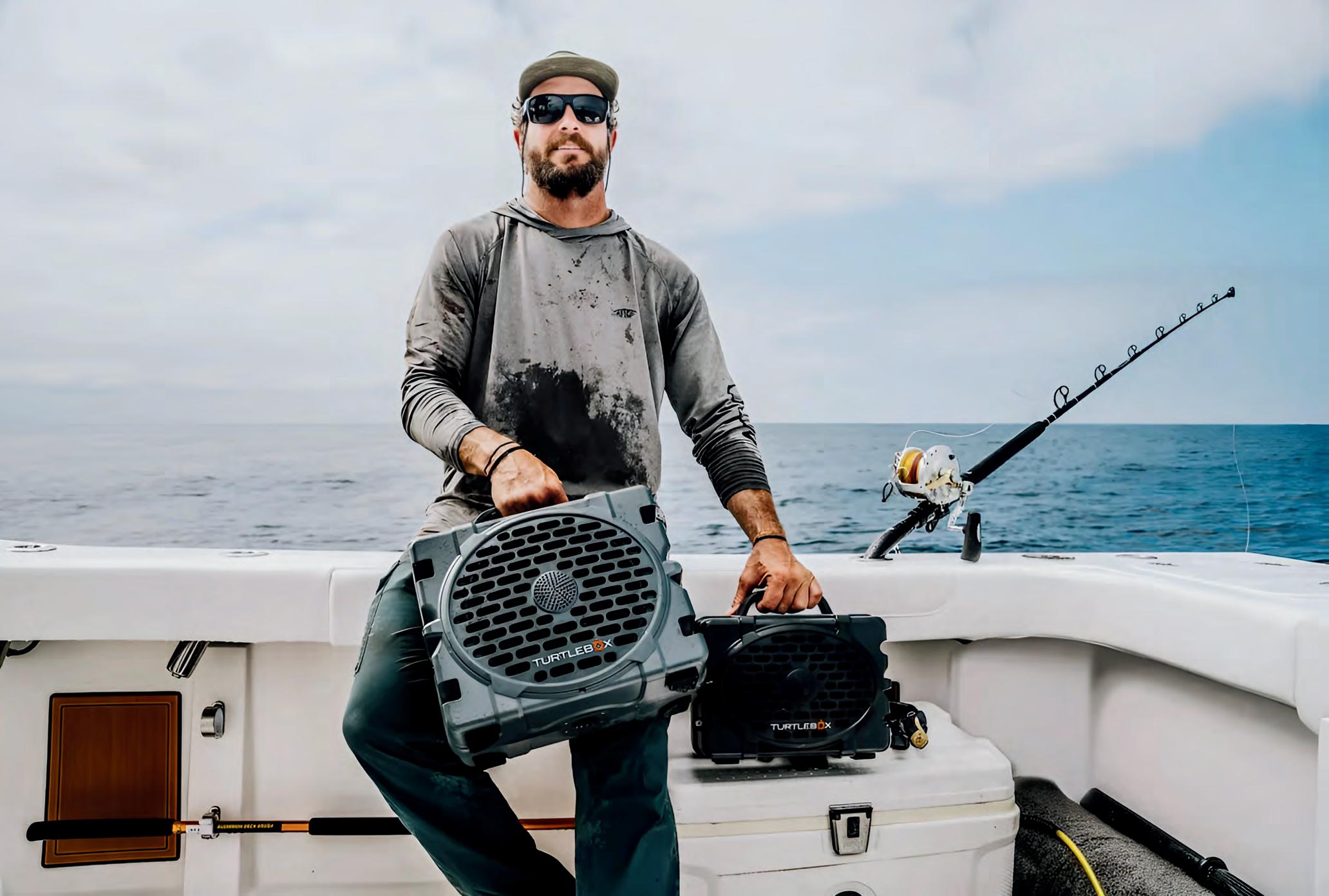








Beach Life Properties consists of three professional real estate agents with Coldwell Banker Sea Coast Advantage. They are all long-time residents of Carteret County and know the beautiful Crystal Coast area intimately. They keep the highest level of integrity and commitment to their clients as well as maintain the highest level of professionalism in the home buying and selling process. The team has built their business on referrals, and commitment to the relationships they have built with their clients. Give one of us a call TODAY!
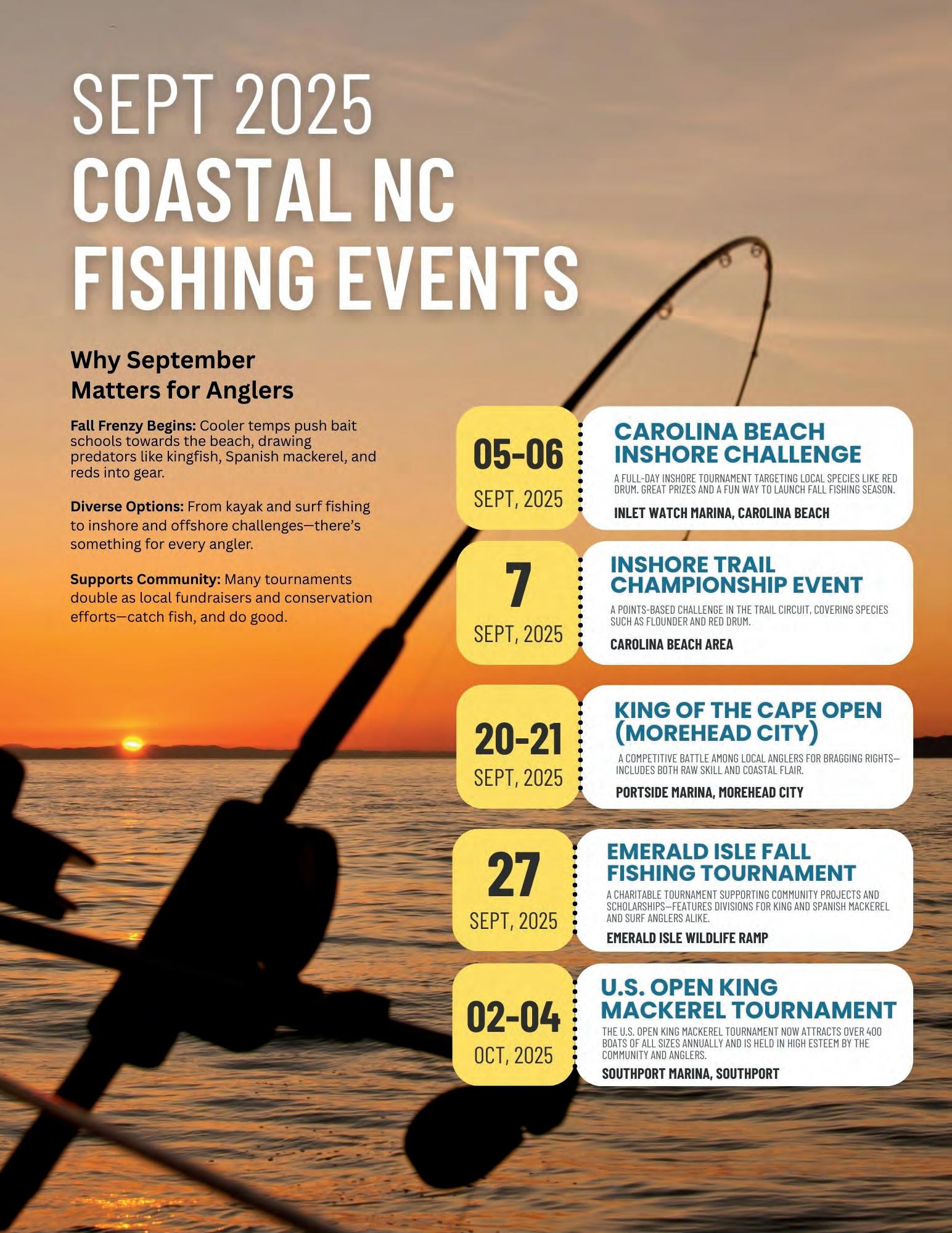










An angler from the Midwest recently had a !shing experience to remember along the banks of the Missouri River near St. Louis.
Wally Klein hooked an enormous 86.8-pound blue cat!sh—an incredible catch that tested both his !shing technique and physical strength.

Using gizzard shad as bait and a standard rod-and-reel setup, Klein fought the powerful !sh before !nally bringing it ashore near Washington, Missouri, according to the Missouri Department of Conservation (MDC).
A er snapping a quick photo to commemorate his achievement, Klein released the massive cat!sh back into the river unharmed.

Klein told MDC o cials it was the largest !sh he’s ever caught. e department congratulated him on the impressive feat, saying, “Congrats on this impressive !sh.”
e Missouri River is a well-known destination for trophy cat!sh, particularly blue cat!sh, which are prized for their size and their spirited !ghts—making them a favorite and true challenge among seasoned anglers.
Klein’s cat!sh was a monster, but it didn’t quite break the state record — which was also set in the Missouri River. Back in 2010, Greg Bernal landed a 130-pound blue cat!sh, a catch that was a world record at the time.
Want to learn more about cat shing Missouri’s big rivers?
Visit: https://mdc.mo.gov/ shing/species/cat sh/big-river-cat shing.



Capt. Mike Smith

The common snook, a.k.a. linesider, a.k.a. robalo, is one of the most sought a er game!sh in Florida waters. Sportsmen and women from all over the world come to Florida to catch these hard !ghting, jumping, head shaking, drag pulling !sh.
Snook will de!nitely eat top water lures, jigs, jerkbaits, wake baits, suspending hard baits, spoons, and ies but they love arti!cial shrimp.
Arti!cial shrimp will catch snook all year long; day or night; salt or fresh water; in every ecosystem, anywhere that snook live.
One of the best ways to catch snook with arti!cial shrimp is skipping them under and around structures like mangrove branches, docks, sea walls, sand bars and oyster bars. Pitch the shrimp to the structure and let it sink. en give it a twitch, twitch and let it sink again, then twitch, twitch and repeat the process until your arms get tired of reeling in linesiders..
Snook like a slower retrieve in the cooler months. Make sure to slow it down when the water temperatures approach the 70 degree level or less. A faster retrieve works better when water temperatures are between 75 and 85 degrees. Snook o en stop biting when water temperatures get above 90 degrees.
Another great characteristic of the arti!cial shrimp is that it skips like a dream. e 3 inch shrimp is the go to arti!cial shrimp lure for most hardcore snook !shermen. However, there are days when the snook are more discerning and a 2.75 inch or a larger 4 inch shrimp is the better size and pro!le choice.
e best color choices for shrimp lures are transparent, natural colors with gold or silver glitter in them for sunny days and clear water scenarios. More opaque and darker colors work better in dirty water and on cloudy days.


Many !shermen struggle when !shing arti!cial lures into tight cover scenarios. Sometimes, it takes about 50 casts and the loss of a half dozen shrimp lures to perfect the technique. But it is de!nitely a skill that any serious snook !sherman needs to master.
Capt. Mike Smith, owner of Fish Your Ass O Charters, is an inshore shing guide who has been shing the inshore waters, oyster bars and grass ats of Florida for more than 40 years. Reach him at (561) 339-2317, email: contact@ shyourasso .com or visit shyourasso .com.








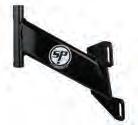










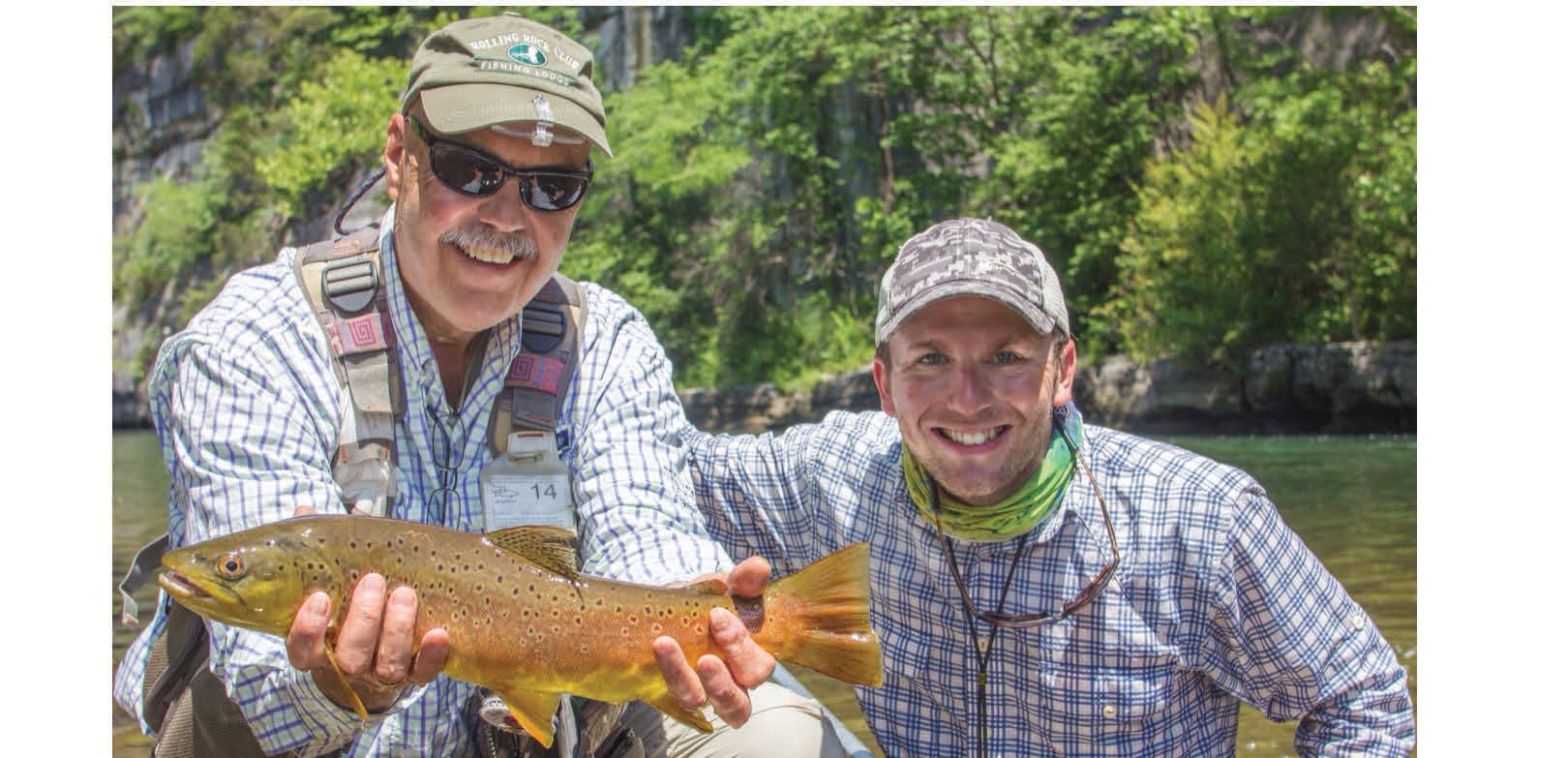



Whether for sport or for the table, pan!sh—especially slab crappies and hand-sized bull bluegills—are a favorite target among anglers. And when the air cools and leaves start to fall, pan!sh !shing heats up. Autumn can be one of the best times to catch these !sh, but it comes with a unique set of challenges. Changing vegetation, dropping water temperatures, lake turnover, and bait!sh migrations can make !nding pan!sh feel like solving a seasonal puzzle.
Fortunately, by learning to read these fall cues you’ll consistently !nd success on the water.
As lake temperatures cool and turnover occurs, bait!sh begin shi ing toward shallower cover where they can !nd safety and warmth. is movement sets o a chain reaction. Pan!sh follow the food, o en stacking up around cover like submerged wood or rocky structure. ese areas become prime real estate for fall !shing.
Weather plays a major role, too. On cold, blustery fall days, pan!sh o en slide deeper, becoming more predictable and easier to !nd with electronics. Deep basin areas in 20 to 25 feet of water can light up with schools of crappies—and sometimes bluegills—suspended and ready to bite. ese deeper !sh are o en aggressive, making for a rewarding but ethically sensitive bite. When !shing at those depths, barotrauma becomes a real issue. Released !sh o en don’t survive, even if they swim o , so it’s important to harvest what you catch, regardless of size.
On the ip side, when the weather is mild and
the sun is out, pan!sh can be found shallower, relating to weedlines, cribs, and brush piles. Healthy, vertical weeds are a magnet for fall pan!sh and can hold !sh all the way into !rst ice. In fact, some of the best fall bluegill bites happen in just !ve to eight feet of water, especially in lakes where dense, green weedbeds persist.
Lake size also in uences fall behavior. On smaller lakes—200 acres or less—dropping water temps and decaying weeds tend to concentrate !sh even more. As long as green weeds remain, pan!sh will hold tight to them. But as those weeds die o , the !sh begin to push toward deeper structure or out into the basins in preparation for winter.
Crappies in particular become more predictable in the fall, o en schooling up tighter and acting more aggressively than during other seasons. ey’re easier to pattern as they transition from summer haunts to winter basins, o en stopping along the way at deep weedlines or submerged timber. In lakes with ample wood or crib structure, these can be hotspots that hold large schools well into late fall.
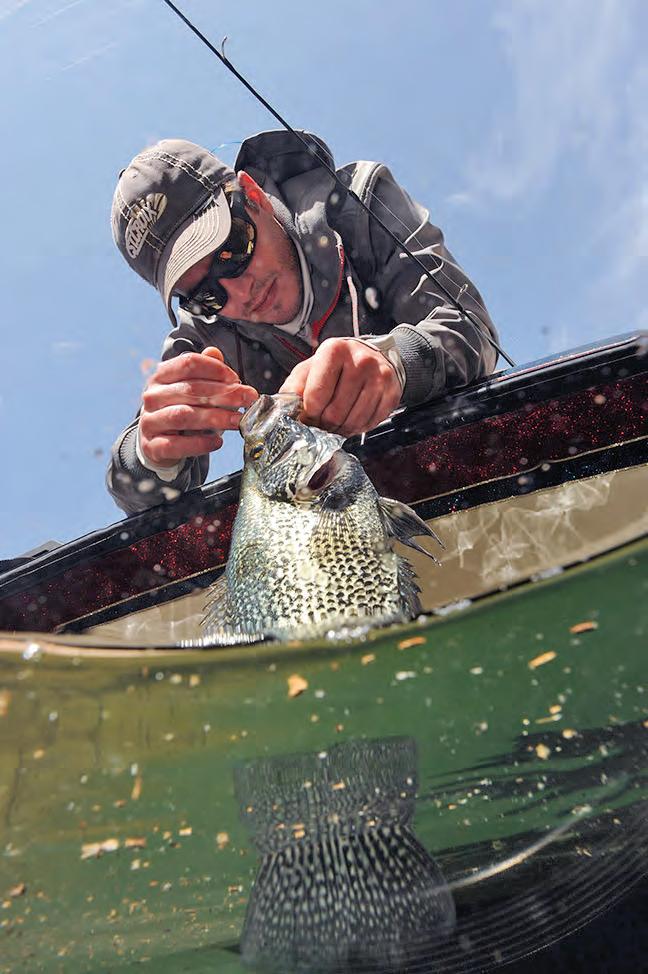
Bluegills, while more opportunistic and scattered, still relate strongly to weed edges and shallow cover when the conditions are right. eir adaptability means they can be caught both shallow and deep, but they may take more searching to !nd than their crappie counterparts.
Despite the variables, the recipe for fall pan!sh
success remains relatively consistent: follow the forage, !nd healthy weeds or cover, and adjust based on the weather. Whether you’re chasing aggressive schools of crappies in deep water or hunting bluegills in shallow weed patches, fall o ers a window of opportunity that savvy anglers won’t want to miss.










Nestled in the heart of the Caribbean, the US Virgin Islands embody a harmonious blend of natural beauty, cultural vibrancy, and laid-back serenity. ese islands are more than just a picturesque getaway; they are a living testament to nature’s rhythm and resilience, e ortlessly in tune with the world around them.
With no passport required for U.S. citizens, from the moment you arrive, the islands’ natural rhythm is palpable. e gentle sway of palm trees, the soothing sound of surf crashing against sandy shores, and the vibrant melodies of local music all echo the heartbeat of this tropical paradise. e islands’ lush landscapes, with their verdant hills and crystal-clear waters, mirror the steady pulse of life that sustains the local ecosystems and communities alike.
e US Virgin Islands’ environment is a symphony of biodiversity with world class !shing and diving. ese natural elements are not static; they dance in harmony, in uenced by the tides, wind, and seasonal changes— further emphasizing the islands’ intrinsic rhythm. is delicate balance underscores the importance of conservation e orts, ensuring that future generations continue to

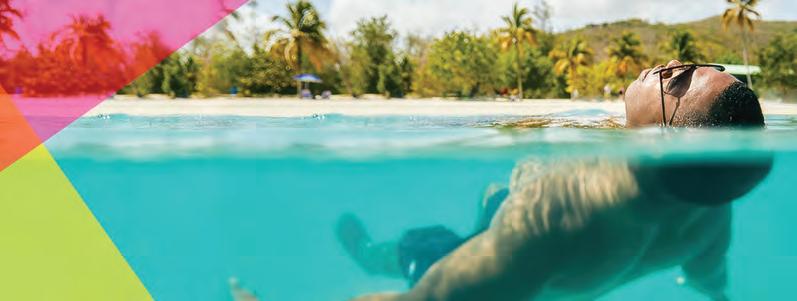
experience the islands’ natural cadence.


Culturally, the US Virgin Islands are equally in tune. e music, dance and festivals re ect a vibrant heritage rooted in African, European and Caribbean traditions. e spirited calypso beats and reggae rhythms are expressions of life's ongoing dance—celebrating resilience, community and joy. ese cultural expressions are an extension of the islands’ natural rhythm, showcasing how human life here moves seamlessly
with nature’s ow.
In a world o en dictated by chaos and rapid change, the US Virgin Islands serve as a reminder of the beauty of being in sync with nature’s tempo. eir natural, cultural and ecological rhythms o er a blueprint for sustainable living and harmony. As travelers and residents alike continue to embrace this rhythm, they uphold a legacy of balance—one that celebrates life’s natural ow and the enduring spirit of these remarkable islands. In the US Virgin Islands, being in rhythm isn’t just an ideal; it’s a way of life.
Learn more at www.VisitUSVI.com.





Buy One, Get One Free
Valued at over $90,000 MSRP, only 3000 tickets will be sold


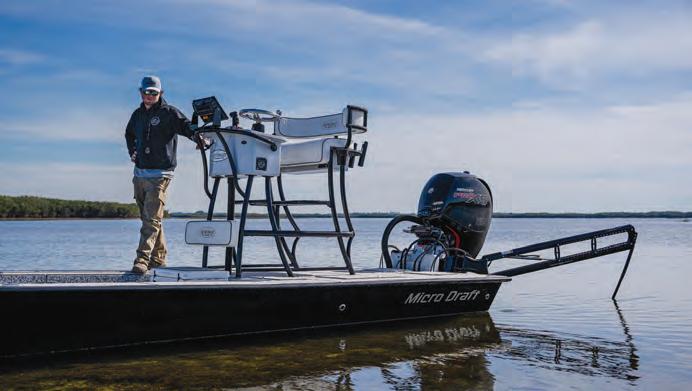








Tim Barefoot

September is a peculiar month. Some of the hottest days of the year, hurricane season is in full swing and the !rst northeast winds and cold fronts are about to occur. is is the time of year when wahoo and yellow!n can be caught right up against the beach on big schools of cigar minnows and sardines, or out in the deeper water. ere is no rhyme or reason to it this time of year; these !sh simply follow the bait schools
is is also the time of year when scamp grouper are very vulnerable. If you have the ability to keep a pin!sh trap in the water, it’s a good idea to take live pin!sh with you o shore for a number of reasons. One, pin!sh are very hearty and will live until the end of the day in the live well. Two, they are very sought a er by scamps because scamps view them as egg eaters and will kill them (eat them) so they don’t eat their eggs. And three, they are readily available at all !sh cleaning stations, at most marinas. Yes, I strongly suggest taking two or three boxes of frozen cigar minnows for bait, but live pin!sh are a ringer for scamps and other grouper/ snapper species in the deeper water.
with a cigar minnow. Proof is in the pudding...and here’s your proof. I’ve always said if you !nd the bait you !nd the !sh, and if you !nd big marks of bait (cigs, sardines, tinks, beeliners etc…) you’ll !nd the !sh. It’s always a good thing to have a “spotlight trolling motor” option to be able to sit on the bait or at least slow your dri in currents, but !sh under the bait on or near the bottom for grouper and snappers and keep the light line out for all the pelagics.
Designate one person in the crew to keep multiple light-line baits tended. Do not let this person get complacent and start bottom !shing. e same person should stay focused on the baits and working the Sabiki for whatever bait is below the boat. I’ve always said “Don’t walk in a Chinese restaurant and order a pizza,” meaning whatever is there is what they’re eating! A couple obvious execptions to this is pin!sh on the bottom and greenies/sardines; these baits are universal. We can’t keep gag grouper this time of year or American red snapper, but you can de!nitely !ll the box with other species.

September is when you will see all the tropical species in places you don’t normally see them. All the tropical snappers are everywhere now. Frozen cigar minnows on the Squid Decoy Jig are a wonderful option, but live cigs and sardines are a “whole nother story.” As shown in the photo, the all-time IGFA world record scamp was caught on the 12 ounce

Be ready for that big bite on the light line by choosing your tackle wisely as well. Yes, you need to keep the leader ( oro and wire) size small to get the bites, but use the correct size hooks, reel and line capacity to handle bigger !sh. Like I mentioned earlier, this is the time of year when wahoo are everywhere...and nowhere. You could catch a giant wahoo or tuna inshore, or in the deep water, just be prepared for it and be ready to chase it down if need be. e kite is always a great option if you have the team that can y the kite and bottom !sh simultaneously as it can be a challenge with wind speed, direction and current.
Learn more from Tim Barefoot on his YouTube channel and at barefootcatsandtackle.com.





